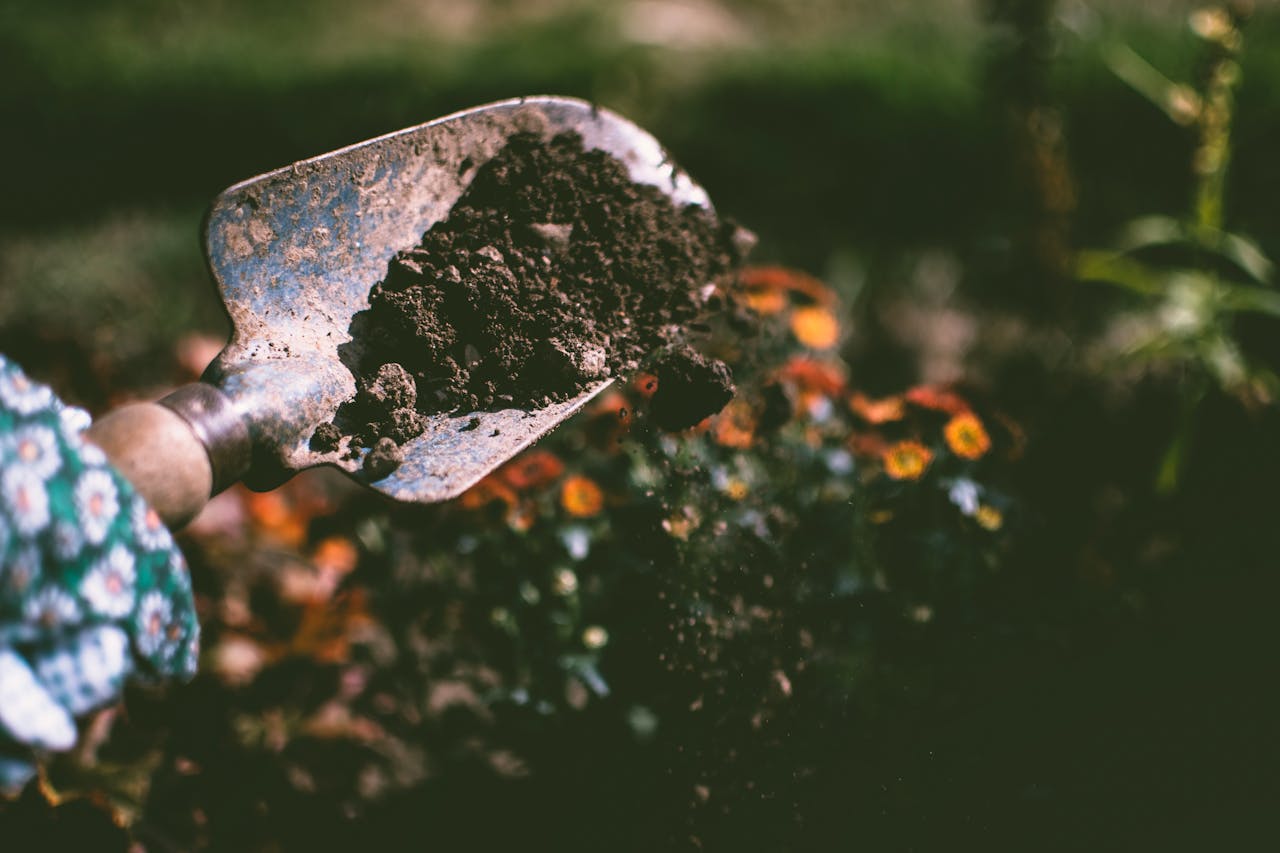
In the quiet corners of a garden, transformation is always under way. What begins as scraps and clippings soon stirs with warmth, turning into something rich and nourishing.
Composting, at its heart, is a slow alchemy that rewards the patient and the curious alike.
Begin with the Perfect Spot and a Sense of Readiness
Before you toss in your first peel or twig, take a moment to choose your location with care.
The sun should reach it often, as warmth fuels decomposition and gives microbes the energy they need to work quickly. A patch that drains well is essential too, so rainwater doesn’t pool and slow the process.
Equally important is airflow. Nestling the pile against a wall may seem tidy, but avoid spots where the breeze can’t pass through. That gentle movement of air helps everything breathe.
And because composting asks for a touch of commitment, place your pile somewhere you can reach easily, even on a rainy day. Once it’s part of your rhythm, you’ll find yourself tending to it as naturally as watering the plants or checking the weather.
If space allows, consider placing it near an outdoor tap. This makes it easier to moisten the pile during dry spells.
In smaller gardens, even a tucked-away corner can work well as long as it receives a few hours of sunlight and stays sheltered from heavy winds.
Gather with Intention, Not Just Enthusiasm
It’s tempting to fling anything organic into the compost, but success begins with selectivity.
Think in pairs: nitrogen-rich greens and carbon-rich browns. The greens bring energy, while the browns keep things steady. Fruit scraps, coffee grounds, and grass clippings are excellent starters, but they need dry leaves, twigs, and cardboard to balance them.
Rather than tossing in great handfuls, consider chopping things down. The smaller the pieces, the quicker they vanish into the mix. You can even keep a small bin or bucket by the kitchen sink to collect your scraps mindfully.
Moreover, avoid anything cooked, oily, or dairy-based, as these disrupt the natural harmony and invite unwanted visitors.
As the weeks pass, you’ll notice how variety encourages diversity in the microbial world. That’s where the real transformation begins.
Some gardeners even add crushed eggshells, which introduce calcium, though they take longer to break down and can appear in the final mix unless crushed finely.
Build Your Heap Like You’re Layering a Meal
There’s no single right way to build your compost pile, but layering helps keep things organised and effective. Begin at the bottom with something loose, like straw or small sticks, to help with airflow. This base will stop the heap from becoming too heavy too soon.
From there, alternate between browns and greens, always favouring a ratio of about two parts brown to one part green. A layer of torn paper followed by vegetable peelings, then some dry leaves, perhaps finished with tea bags or grass.
The rhythm is your own to find, but consistency pays off.
Beyond that, tucking in a bit of soil or mature compost between layers introduces helpful microbes. Keep the pile just over a metre tall, and press it down lightly as you go, leaving space for air to move through.
With each tier, you’re not only building a heap but encouraging a living process to unfold.
If you live in a colder climate or are composting through the winter, you should consider insulating the sides with wooden slats or straw bales. This helps retain heat and protects the microbial activity from slowing too much as temperatures drop.
Stir the Warmth and Let Curiosity Guide You
Now that your pile has begun, turning it regularly becomes part of its care. Every week or two, take a fork and gently mix it through.
Pull the outer edges into the centre and bring the hot middles outward. This encourages even decomposition and stops sections from becoming stale.
Listen to what your compost tells you. A sudden drop in heat might mean it’s time for another turn. A slight sour smell may point to too much green and not enough dry matter. These cues are helpful rather than worrying.
Furthermore, it’s worth noting that stirring the pile becomes an oddly grounding task. You’re tending to something hidden, helping it become more than the sum of its parts.
In the end, it’s the air, movement, and attention that make the difference.
Compost tumblers (rotating bins) can be a useful alternative if physical turning feels too labour-intensive. They simplify aeration and are particularly handy in smaller gardens, although they tend to produce smaller quantities at a slower rate.
Keep It Warm, Keep It Damp, Keep It Going
To work well, your compost pile needs to stay both warm and moist, without tipping too far in either direction.
Aim for the dampness of a wrung-out cloth, not dripping wet, just gently moist. If things seem too dry, a sprinkle of water helps. If too soggy, add straw or shredded newspaper and turn it through.
Temperature plays a part as well. Between 55 and 70 degrees Celsius is ideal, though you’ll often feel the heat with your hand or see a little steam rise when you turn it.
During rainy periods, cover the pile with breathable fabric or a simple tarp. This helps it hold onto its heat and prevents the balance from being disrupted by excess moisture.
Consistency matters more than perfection. Even in winter, when things naturally slow, maintaining the right conditions keeps your compost alive and ticking over.
You can also introduce aeration tubes or perforated PVC pipes in the centre of the heap to improve airflow without constant turning. This passive method suits gardeners seeking a low-maintenance system that still yields excellent results.
Know When to Stop, and When to Start Again
As the pile nears maturity, it helps to know when to pause. Once it’s two-thirds full and running warm, hold off on new additions. Let the existing materials settle and break down completely. Set up a second pile for anything new, so the first can finish properly.
When your compost becomes dark, crumbly, and smells like forest soil, it’s ready to use.
You can sieve it if you prefer a finer texture or simply remove any large bits for your next batch. Spread it over flowerbeds, dig it into borders, or revive tired containers with a generous layer.
And if it all feels too much at times, there’s no shame in seeking support. Many individuals factor in the local gardening cost of hiring someone to help set up a system or turn compost now and then.
What matters is keeping the process going, in whatever way suits your space and routine.
With time, the rhythm of adding, pausing, and harvesting becomes second nature, turning the composting cycle into something as natural as planting seeds or watching the seasons shift.
Conclusion
Composting asks little but gives a great deal in return. With patience, a bit of care, and a place for things to settle, the garden begins to give back in kind.
Let the heap do its work, and you’ll soon find nature meeting you halfway.



